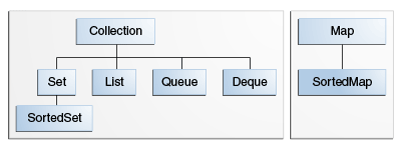Lesson: Interfaces
来源:互联网 发布:真实的朝鲜 知乎 编辑:程序博客网 时间:2024/05/19 00:12
The core collection interfaces encapsulate different types of collections, which are shown in the figure below. These interfaces allow collections to be manipulated independently of the details of their representation. Core collection interfaces are the foundation of the Java Collections Framework. As you can see in the following figure, the core collection interfaces form a hierarchy.

The core collection interfaces.
A Set is a special kind of Collection, a SortedSet is a special kind ofSet, and so forth. Note also that the hierarchy consists of two distinct trees — aMap is not a true Collection.
Note that all the core collection interfaces are generic. For example, this is the declaration of theCollection interface.
public interface Collection<E>...
The <E> syntax tells you that the interface is generic. When you declare aCollection instance you can and should specify the type of object contained in the collection. Specifying the type allows the compiler to verify (at compile-time) that the type of object you put into the collection is correct, thus reducing errors at runtime. For information on generic types, see the Generics (Updated) lesson.
When you understand how to use these interfaces, you will know most of what there is to know about the Java Collections Framework. This chapter discusses general guidelines for effective use of the interfaces, including when to use which interface. You'll also learn programming idioms for each interface to help you get the most out of it.
To keep the number of core collection interfaces manageable, the Java platform doesn't provide separate interfaces for each variant of each collection type. (Such variants might include immutable, fixed-size, and append-only.) Instead, the modification operations in each interface are designated optional — a given implementation may elect not to support all operations. If an unsupported operation is invoked, a collection throws anUnsupportedOperationException. Implementations are responsible for documenting which of the optional operations they support. All of the Java platform's general-purpose implementations support all of the optional operations.
The following list describes the core collection interfaces:
Collection— the root of the collection hierarchy. A collection represents a group of objects known as itselements. TheCollectioninterface is the least common denominator that all collections implement and is used to pass collections around and to manipulate them when maximum generality is desired. Some types of collections allow duplicate elements, and others do not. Some are ordered and others are unordered. The Java platform doesn't provide any direct implementations of this interface but provides implementations of more specific subinterfaces, such asSetandList. Also see The Collection Interface section.Set— a collection that cannot contain duplicate elements. This interface models the mathematical set abstraction and is used to represent sets, such as the cards comprising a poker hand, the courses making up a student's schedule, or the processes running on a machine. See also The Set Interface section.List— an ordered collection (sometimes called a sequence).Lists can contain duplicate elements. The user of aListgenerally has precise control over where in the list each element is inserted and can access elements by their integer index (position). If you've usedVector, you're familiar with the general flavor ofList. Also seeThe List Interface section.Queue— a collection used to hold multiple elements prior to processing. Besides basicCollectionoperations, aQueueprovides additional insertion, extraction, and inspection operations.Queues typically, but do not necessarily, order elements in a FIFO (first-in, first-out) manner. Among the exceptions are priority queues, which order elements according to a supplied comparator or the elements' natural ordering. Whatever the ordering used, the head of the queue is the element that would be removed by a call to
removeorpoll. In a FIFO queue, all new elements are inserted at the tail of the queue. Other kinds of queues may use different placement rules. EveryQueueimplementation must specify its ordering properties. Also see The Queue Interface section.Deque— a collection used to hold multiple elements prior to processing. Besides basicCollectionoperations, aDequeprovides additional insertion, extraction, and inspection operations.Deques can be used both as FIFO (first-in, first-out) and LIFO (last-in, first-out). In a deque all new elements can be inserted, retrieved and removed at both ends. Also seeThe Deque Interface section.
Map— an object that maps keys to values. AMapcannot contain duplicate keys; each key can map to at most one value. If you've usedHashtable, you're already familiar with the basics ofMap. Also seeThe Map Interface section.
The last two core collection interfaces are merely sorted versions of Set andMap:
SortedSet— aSetthat maintains its elements in ascending order. Several additional operations are provided to take advantage of the ordering. Sorted sets are used for naturally ordered sets, such as word lists and membership rolls. Also see The SortedSet Interface section.SortedMap— aMapthat maintains its mappings in ascending key order. This is theMapanalog ofSortedSet. Sorted maps are used for naturally ordered collections of key/value pairs, such as dictionaries and telephone directories. Also seeThe SortedMap Interface section.
To understand how the sorted interfaces maintain the order of their elements, see theObject Ordering section.
- Lesson: Interfaces
- Interfaces
- Interfaces
- interfaces
- 8.9 Interfaces
- 20. Interfaces
- IObjectSafety (Interfaces)
- Designing Interfaces
- IObjectSafety (Interfaces)
- 《Designing Interfaces》
- ubuntu interfaces
- Device Interfaces
- Android Interfaces
- GPIO Interfaces
- Python Interfaces are not Java Interfaces
- hacking SecureCRT Script Interfaces
- Interfaces vs Abstract Classes...
- Very Dynamic Web Interfaces
- js 获取当前日期
- UITextField 详情
- ie6中window.location.href不能跳转解决
- 设置属性 放于属性窗口中
- 【JAVA/swing】eclipse的jigloo插件可视化开发java swing/SWT.安装及使用演示。
- Lesson: Interfaces
- Android sdk Manager 无法下载的解决方法
- 交叉编译zlib-1.2.8
- MD5
- 在c/c++中赋值符的优先级大于++/--
- nyist oj 138 找球号(二)(hash 表+位运算)
- asymptotic notation and recursion
- hdu1255--覆盖的面积(线段树+离散化+扫描线)
- SPOJ 1881 Instruction Decoder


